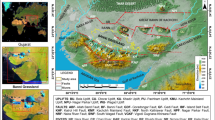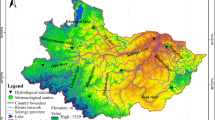Abstract
The Tineh Plain NW Sinai coast has been the subjected of several studies related to its stratigraphy, geoarchaeology, and sustainable development. Recently, the name of the Tineh Plain has emerged following the government of Egypt’s decision to establish a new economic project to develop the Suez Canal Sector (Suez Canal Corridor Mega Project). Landsat and SPOT satellite images acquired for years 1984, 2000, 2006, 2008 and 2010 to detect temporal changes coupled with field relations, verification, sampling, analyzing and photographing were conducted. Change detection of LU/LC show six classes; the beach, the wetland (El-Mallaha lagoon), Sabkhas or salt marshes, urban, agriculture, and fish breeding farms. In 1984, the beach (4.2 km2), El-Mallaha lagoon (26.4 km2), sabkhas or salt marches (236.7 km2) were reduced due to expansion of agriculture (120.3 km2), fish breeding farms (35.7 km2) and controlled by sediment characteristic (salinity and grain size). Accordingly, fish farms grow northward of the Tineh Plain while reclamation and cultivation extends southward. Such activities may threaten the archaeological sits at Tell El-Farama (The City of Pelusium). Three geomorphic units detected, these are the beach, the strand plain, and the deltaic plain. The beach is flat with concavo (accreted) - convex (eroded) shoreline. The strand plain made of accreted beach ridges of very low bundles, set at slight mutual angles, which sometimes truncate one another. The deltaic plain surface composed of intercalations of sand and mud of shoreface, mouth bar, and distributary channel fill. The accreted ridges representing four paleoshorelines related to Late Holocene and dated back to 400–500BP, 1100–1200BP, 1400–1500BP, and 1700–1900BP, those record the Late Holocene history (sea level, floods, and tectonics) of the Tineh Plain. The study area is waiting a plan of sustainable development, it represents phase “A” East Port Said of the Suez Canal Corridor Mega Project. This study raise the alarm of constructing heavy industries and other logistics related to shipping on the fragile environments of the Tineh Plain. This is in fact due to active tectonism, and sediment characteristics. The activities related to agriculture, fish breeding, and salts and food industries are recommended in the framework of sustainable development. It is important to include the Suez Canal Corridor Project a plan to save the ruins of fortifications of Tineh Plain. These are not only Egyptian heritage but also a world one record the history from the Persian invasions of Egypt about 6th or 7th Century B.C., through the Byzantines in 859–860, the Greeks in 954–955, the Arabic Conquest, and the Crusaders in the 12th Century. A cooperation and support from the international organization such as UNESCO should be conducted.










Similar content being viewed by others
References
Arnous MO (2011) Integrated remote sensing and GIS techniques for landslide hazard zonation: a case study Wadi Watier area, South Sinai, Egypt. J Coast Conserv 15:477–497. doi:10.1007/s11852-010-0137-9
Arnous MO, Green DR (2011) GIS and remote sensing as tools for conducting geo-hazards risk assessment along Gulf of Aqaba coastal zone, Egypt. J Coast Conserv 15:457–475. doi:10.1007/s11852-010-0136-x
Baeteman C, Waller M, Kiden P (2011) Reconstructing middle to late Holocene sea-level change: a methodological review with particular reference to ‘a new Holocene sea-level curve for the southern North Sea’ presented by K.-E. Behre. Boreas, 10.1111/j.1502-3885.2011.00207.x
Bouriant U (1900) Maqrizi: Description Topographique et Historique de l’Egypte (Part II) [translation ofthe 14th century Arabic work]. Mémoires Publiés par les Membres de la Mission Archéologique Française du Caire 17 371–748
Casanova MP (1906) Maqrizi, Description Topographique et Historique de l’Egypte (Part III) [translation from Arabic]. Mémoires Publiés par les Membres de l’Institut Français d’Archéologie Orientale du Caire 3 1–328
Chavez PS (1996) Image-based atmospheric correction—revised and improved. Photogramm Eng Remote Sens 62:1025–1036
Chichagov VP (2013) The northern Sinai extra-arid plain and its origin. Geogr Nat Resour 34(3):285–290
Dennis RA, Colfer CP (2006) Impacts of land use and fire on the loss and degradation of lowland forest in 1983–2000 in East Kutai District, East Kalimantan, Indonesia Singapore. J Trop Geogr 27:30–48
Dewidar KHM (2004) Detection of land use/land cover changes for the northern part of the Nile delta (Burullus region), Egypt. Int J Remote Sens 25:4079–4089
Dewidar KHM, Frihy OE (2003) Thematic Mapper analysis to identify geomorphologic and sediment texture of El-Tineh plain north-western coast of Sinai, Egypt. Int J Remote Sens 24:2377–2385
El-Asmar HM (1999) Late Holocene stratigraphy and lithofacies evolution of the Tineh plain Northwestern corner of Sinai, Egypt. Egypt J Geol 43(2):119–134
El-Asmar HM (2002) Short term coastal changes along Damietta–Port Said coast northeast of the Nile Delta, Egypt. J Coast Res 18(3):433–441
El-Asmar HM, Al-Olayan HA (2013) Environmental impact assessment and change detection of the coastal desert along the central Nile Delta coast, Egypt. Int J Remote Sens Appl 2(2):24–29
El-Asmar HM, Hereher M, El-Kafrawy S (2012) Threats facing lagoons along the north coast of the Nile Delta, Egypt. Int J Remote Sens Appl 3(3):159–170
El-Asmar HM, Hereher M, El-Kafrawy S (2013) Surface area change detection of the Burullus Lagoon, North of the Nile Delta, Egypt, using water indices: a remote sensing approach. Egypt J Remote Sens Space Sci. doi:10.1016/j.ejrs.2013.04.004
El-Asmar HM, El-Kafrawy S, Taha MMN (2014) Monitoring coastal changes along Damietta Promontory and the barrier beach toward Port Said east of the Nile Delta, Egypt. J Coast Res 30(5):993–1005. doi:10.2112/JCOASTRES-D-12-00112.1
El-Banna M, Hereher M (2009) Detecting temporal shoreline changes and erosion/accretion rates, using remote sensing, and their associated sediment characteristics along the coast of North Sinai, Egypt. Environ Geol 58:1419–1427. doi:10.1007/s00254-008-1644-y
El Gammal EA (2013) Implication of Holocene catastrophic tectonic activities on archaeological sites at Mediterranean shore North West Sinai Egypt. Aust J Basic Appl Sci 7(9):221–234
EPM (2014) Master plan for Port Said East Port http://epmcon.com/article/23883/Master-Plan-For-Port-Said-East-Port
Fontaine AL (1951) Enquete sur Peluse. Bullde la soc d’ Etudes Histo et Geogra de l’ Isthmus de Suez 4:2–97
Foody G (2003) Remote sensing of tropical forest environments: towards the monitoring of environmental resources for sustainable development. Int J Remote Sens 24:4035–4046
Frihy OE, Lotfy MF (1997) Shoreline changes and beach-sand sorting along the northern Sinai coast of Egypt. Geo-Mar Lett 17:140–146
GAFI (2014) MEGA projects, integrated development at the center of the of the Suez Canal. http://www.mfa.gov.eg/MFANews/NewsArabic/Documents/Mega%20Projects%2023-1-2013.pdf
Gamal MA (2013) Truthfulness of the existence of the Pelusium Megashear fault system, east of Cairo, Egypt. Int J Geosci 4:212–227
Gehrels (2010) Late Holocene land- and sea-level changes in the British Isles: implications for future sea-level predictions. Quat Sci Rev 29:1648–1660
Goodfriend GA, Stanley DJ (1999) Rapid strand-plain accretion in the northeastern Nile Delta in the 9th century AD and the demise of the port of Pelusium. Geology 27:147–150
Herold M, Scepan J, Clarke KC (2002) The use of remote sensing and landscape metrics to describe structures and changes in urban land uses. Environ Plan 34:1443–1458
Kaiser M (2009) Environmental changes, remote sensing, and infrastructure development: the case of Egypt’s East Port Said harbour. Appl Geogr 29:280–288
Lillesand TM, Kiefer RW (1994) Remote sensing and image interpretation. Wiley, New York
Lillesand TM, Kiefer RW, Chipman JW (2004) Remote sensing and image interpretation. Wiley, New York
Lu D, Mausel P, Brondizio E, Moran E (2004) Change detection techniques. Int J Remote Sens 25:2365–2404
Lunetta RS, Elvidge CD (1998) Remote sensing change detection: environmental monitoring methods and applications. Ann Arbor Press, Michigan
Mass JF (1999) Monitoring land-cover changes: a comparison of change detection techniques. Int J Remote Sens 20:139–152
McFeeters SK (1996) The use of normalized difference water index (NDWI) in the delineation of open water features. Int J Remote Sens 17:1425–1432
Morhange C, Pirazzoli PA, Marriner N, Montaggioni LF, Nammour TD (2006) Late Holocene relative sea-level changes in Lebanon, Eastern Mediterranean. Mar Geol 230:99–114
Mukherjee S, Shashtri S, Singh C, Srivastava P, Gupta M (2009) Effect of canal on land use/land cover using remote sensing and GIS. J Indian Soc Remote Sens 37:527–537
Neev D (1977) The Pelusium line a major transcontinental shear. Tectonophysics 38:1–8
Neev D, Greenfield L, Hall JK (1985) Slice tectonics in the Eastern Mediterranean basin. In: Stanley DJ, Wezel FC (eds) Geological evolution of the Mediterranean Basin. Springer, Verlage, pp 264–269
Otvos EG (2000) Beach ridges –definition and significance. Geomorphology 32:83–108
Reineck EH, Wunderlich F (1968) Classification and origin of flaser and lenticular bedding. Sedimentology 11:99–104
Rizzini A, Vezzani F, Cococcetta V, Mild G (1978) Stratigraphy and sedimentation of the Neogene-quaternary section in the Nile Delta area. Mar Geol 11:99–104
Saadat H, Adamowski J, Bonnell R, Sharifi F, Namdar M, Ebrahim SA (2011) Land use and land cover classification over a large area in Iran based on single date analysis of satellite imagery. ISPRS J Photogramm Remote Sens 66:608–619
SCC (2013) The technical secretariat for the suez canal corridor development first conference, Cairo, Egypt
Serra P, Pons X, Saurı D (2003) Post-classification change detection with data from different sensors: some accuracy considerations. Int J Remote Sens 24:3311–3340
Shalaby A, Tateishi R (2007) Remote sensing and GIS for mapping and monitoring land cover and land-use changes in the Northwestern coastal zone of Egypt. Appl Geogr 27:28–41
Shao Y, Lunetta RS (2012) Comparison of support vector machine, neural network, and CART algorithms for the land-cover classification using limited training data points. ISPRS J Photogramm Remote Sens 70:78–87
Shennan I, Milne G, Bradley S (2012) Late Holocene vertical land motion and relative sea level changes: lessons from the British Isles. J Quat Sci 27(1):64–70
Sneh A, Weissbrod T (1973) Nile Delta: the defunct Pelusiac branch. Science 180:59–61
Sneh A, Weissbrod T, Perath I (1975) Evidence for ancient Egyptian frontier canal. Am Sci 63:543–548
Srivastava PK, Han D, Rico-Ramirez MA, Bray M, Islam T (2012) Selection of classification techniques for land use/land cover change investigation. Adv Space Res 50(9):1250–1265
Stanley DJ (1988) Subsidence in the northeastern Nile Delta: rapid rates, possible cause, and consequence. Science 240:497–500
Stanley DJ, Bernasconi MP, Jorstadt TF (2008) Pelusium, an ancient port fortress on Egypt’s Nile Delta coast: its evolving environmental setting from foundation to demise. J Coast Res 24(2):451–462
Stuiver M, Polash HA (1977) Reporting of C14 data. Radiocarbon 19(3):355–363
Tamari S (1978) Qalat Al-Tina in Sinai: a historical architectural analysis. Annali del Instituto Orientale di Napoli 38(suppl 16):1–78
Taylor M, Stone GW (1996) Beach-ridges: a review. J Coast Res 12(3):612–621
Wood P (1996) Dating and origin of late quaternary catastrophic shoreline activity around the Mediterranean Sea. Unpublished Ph.D. Thesis, University of London
Xu H (2006) Modification of normalized difference water index (NDWI) to enhance open water features in remotely sensed imagery. Int J Remote Sens 27:3025–3033
Yuan F, Sawaya KE, Loeffelholz BC, Bauer ME (2005) Land cover classification and change analysis of the Twin Cities (Minnesota) Metropolitan Area by multitemporal Landsat remote sensing. Remote Sens Environ 98:317–328
Zaafarany N, Alsahar S. (2014) The prospects of developing Suez Canal region- a futuristic vision. Vienna 10th International Academic Conference
Acknowledgments
The authors dedicated this work to the late memory of Dr. Yannis Foundolis, Department of Geology, Athens University, without his critical support in age dating, the work cannot be accomplished. The authors would like to extend their sincere appreciation to the Deanship of Scientific Research of King Saud University for funding this research group No [RG-1435-033].
Author information
Authors and Affiliations
Corresponding author
Rights and permissions
About this article
Cite this article
El-Asmar, H.M., Taha, M.M.N., El-Kafrawy, S.B. et al. Control of Late Holocene Geo-processes on the sustainable development plans of the Tineh Plain, NW Sinai coast, Egypt. J Coast Conserv 19, 141–156 (2015). https://doi.org/10.1007/s11852-015-0377-9
Received:
Revised:
Accepted:
Published:
Issue Date:
DOI: https://doi.org/10.1007/s11852-015-0377-9




